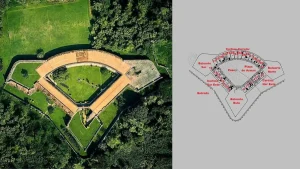Pre-Hispanic Period in Honduras
Before the Spanish Conquest, Honduras was inhabited by peoples characterized by two different cultural types, formed as a result of migrations that populated the American continent in pre-Columbian times. The Maya and Aztec cultures were governed by the so-called «Asiatic mode of production,» whose most outstanding characteristic was the existence of a «sedentary» economy based on agricultural production, with collective relations of production centralized under a single power exercised by a group of civil, religious, and military officials. Therefore, they were not egalitarian societies. Class division was established between those who held power and the majority of the population.
These cultures made great progress in various fields of human knowledge, driven by the development of diverse agriculture (beans, cocoa, chili, etc.) and had extensive irrigation systems. This ensured adequate food for their numerous populations. They also applied techniques of great perfection in textiles and ceramics. They developed intense and diverse trade. They achieved advanced scientific development in mathematics and astronomy, as well as architecture and sculpture, which they employed in the construction of large cities.
In the northwestern section of Honduras, the Ch’orti’s, a Mayan group located in Copán, Copán and Ocotepeque, and the Lenca people predominated, extending across the departments of Santa Bárbara, Lempira, Intibucá, La Paz, Comayagua, Francisco Morazán, Valle, and part of what now comprises the territory of El Salvador.
The rest of the Honduran territory was inhabited by peoples from the south of the continent, with a nomadic and semi-nomadic culture, governed by primitive communal relations of production. Among these peoples were the Xicaques, Pechs, Tawahkas, and Miskitos, who together formed the majority of the country’s population. It was not until the second half of the 1700s that other ethnic groups were formed along the coastal zone of the Caribbean coast: the Garifuna and the English-speaking Creole blacks.
The most populous group was the Lenca people who, at the time of the arrival of the Spanish, were the most widespread and organized groups in the country. They inhabited towns of considerable size, with an average of 350 houses and more than 500 inhabitants. Although there are scientific controversies regarding the descent and origin of the Lenca people, according to Rodolfo Barón Castro, they are the direct descendants and heirs of the Maya, who did not follow the exodus that marked the end of the Ancient Empire. At the arrival of the Spanish, they were established in the territory now comprising the Republics of El Salvador and Honduras.»
The Maya area includes what are now the countries of Honduras, Guatemala, El Salvador, and Mexico. The Maya civilization flourished in these countries in the first 15 centuries of the Christian era. Unknown causes to this day led to the abandonment and destruction of Copán and other Maya cities, which by the time of the Spanish conquest were nothing more than ruins. Hunger, plagues, and internal conflicts have been proposed as the causes of abandonment.



